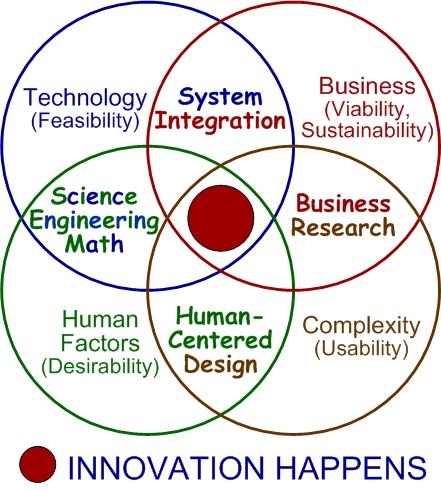Managing Complexity & Reducing Risk
June 10, 2013

This column, over the years, has had the theme that human-centered, model-based design is the most direct path to insight and innovation. The Innovation Diagram below shows the added importance of viability and sustainability, and also introduces the need to manage complexity. We are now surrounded by high-risk technological systems in all aspects of our lives. Is the potential for catastrophic failure inherent in the system itself or in the way the system was designed? Charles Perrow, in his most relevant book, Normal Accidents (Princeton University Press, 1999), addresses this question and develops an explanation based on system characteristics.
Systems are fundamentally made up of components or parts. A functionally related collection of components forms a unit. An array of units forms a subsystem, which all come together to form the system. An accident is a failure in a subsystem, or the system as a whole, that damages more than one unit and in so doing disrupts the ongoing or future output of the system. What systems are prone to system accidents? To answer this, two concepts need to be considered: interactiveness and coupling.

The notion of baffling system interactions is increasingly familiar to all of us. Interactiveness is not a problem if the interactions are expected and obvious. However, components sometimes have a common-mode function in that if it fails, other modes fail; the situation gets more complex. Ironically, complexity is often added to a system to reduce common-mode failures. Proximity and indirect information sources are two other indicators of interactiveness. Simple, comprehensible interactions are predominant in all systems. But as the complexity of a system increases, the probability that baffling, unintended interactions exist, not intended in the design, increases dramatically. This classification is fuzzy and systems must be characterized in terms of the degree of either quality. Complex systems are not undesirable. They typically are more efficient with less slack, but they have the potential for catastrophic failure.
The second concept to consider is coupling. Tightly coupled systems have more time-dependent processes, the sequences are invariant, and there is little slack. The overall design of the system allows only one way to reach the goal. Coupling is particularly germane to recovery from inevitable component failures. In tightly coupled systems, the buffers, redundancies, and substitutions must be designed in; they must be thought of in advance. In loosely coupled systems there is a better chance that expedient, spur-of-the-moment buffers, redundancies, and substitutions can be found.
The world of systems can be organized according to the two, largely independent variables interaction and coupling, in a two-variable array: loose vs. tight coupling and predictable vs. baffling interactions. Some subjective examples are the following: loosely coupled, predictable systems include assembly-line production and most manufacturing, while tightly coupled, predictable systems include rail transport and dams.
There are no answers here. Engineers must manage complexity and prevent catastrophic failures. Interactiveness and coupling concepts should aid engineers in accomplishing that goal.
Related posts:
About the Author(s)
You May Also Like



